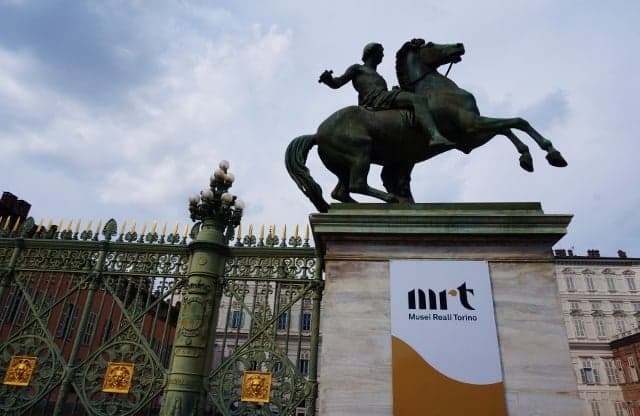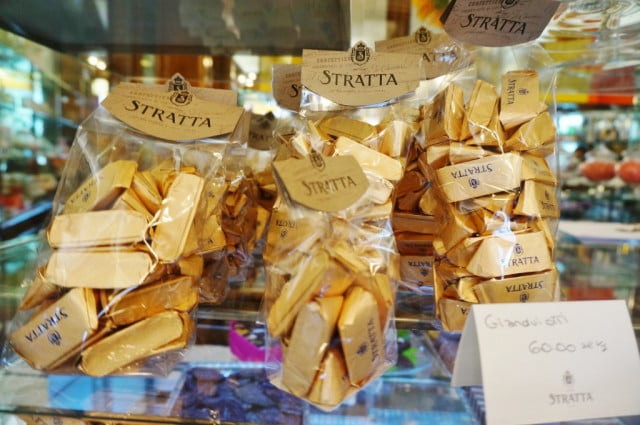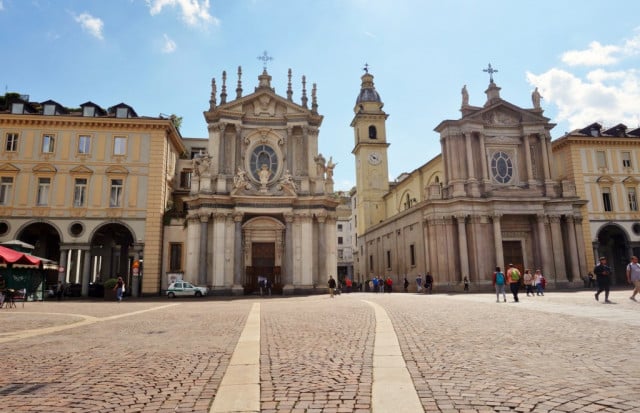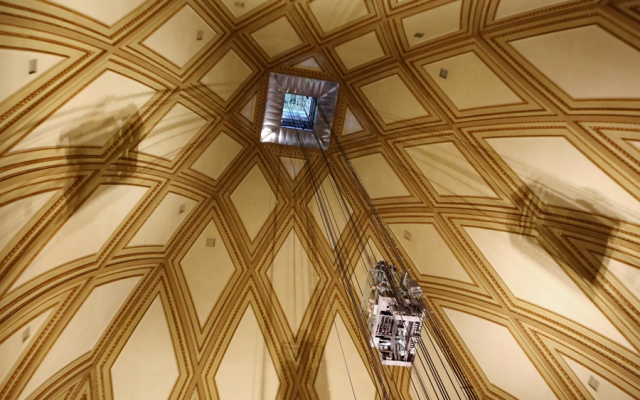Weekend Wanderlust: A love letter to Turin

Indulgent, elegant and unpretentious, it's hard not to fall head over heels for this completely underrated Italian city.
With Turin, it was love at first sight. Or maybe it was at first taste.
“Don’t bite into it. Wait. Just let it melt slowly in your mouth,” my guide Laura instructed, as I stood perfectly still in the middle of the Stratta café, eyes closed, feeling a little bit silly. Until the gooey chocolate melted and I understood what the fuss was about.
This was a lesson in eating gianduiotti, tiny chocolates with a rich hazelnut cream centre, as the Torinesi apparently do: by letting the whole thing melt slowly on the tongue.
They were designed to be eaten delicately, and all in one go, by the city’s aristocracy at elegant palace parties. Obviously no one there wanted to risk smearing chocolate on themselves.
Gianduiotti chocolates for sale at a shop in Turin. Photo: Clare Speak/The Local
Hazelnut chocolate cream or crema gianduia is a big deal here in Turin. It’s in everything from gelato to pastries. It’s the somewhat classier ancestor of Nutella, which was invented here. (If you think Nutella is addictive, just wait until you get your hands on a tub of crema gianduia.)
It was apparently invented in 1806, when Napoleon’s wars in South America made cocoa beans so astronomically expensive in the Savoy kingdom that local chocolatiers were going out of business.
Luckily, the nearby Piedmont countryside is full of hazelnut trees, and it didn’t take long to figure out a delicious way of stretching the cocoa supply.
The city’s arcades and porticos - a useful place to hide from strong sunshine, or just as often, rain - are still lined with lavishly decorated cafes and chocolate shops. The lack of tourists in Turin means that they cater to local people, so quality is high.
.jpg)
One of Turin's many lavishly decorated cafes dating back to the turn of the last century. Photo: Clare Speak/The Local
Out on the city’s main square, Piazza San Carlo, there were just a handful of people having coffee on a weekday morning, and not a tour group in sight. A few visitors milled around inside the San Carlo and Santa Cristina churches which flank the road to the train station.
.jpg)
The interior of the Church of Santa Cristina in Turin. Photo: Clare Speak/The Local
The other buildings on the square, with their elegant facades, give little away. But several of them are actually palaces, with incredibly sumptuous inner rooms. The former home of the Marquis Solaro del Borgo, for example, is now the Accademia Filharmonica; its grand halls brimming with gilded stucco, baroque furniture, gold-framed mirrors and countless chandeliers dating from the time of Louis XVI.
But the facades, while grand, are much more restrained and are painted in muted colours. Apparently Turin’s richest families were keen to avoid ‘vulgar’ outward displays of wealth, so palaces were built in more or less the same style and height; even the façade of the Royal Palace fits in. All the extravagance was apparently saved for the interiors.

Turin's main square, Piazza San Carlo. Photo: Clare Speak/The Local
People here still dislike showing off, Laura told me. It’s definitely not the kind of city where you’ll see flash cars and oyster bars, despite it being so wealthy. And some designer shops have had to supply special plain carrier bags, as requested by their unusually modest, designer logo-averse customers.
While it’s not quite Milan, Turin is has lots of shopping streets with plenty of both high street and high-fashion brands, including a few local designers. A good place to start exploring the shops here is from Via Roma, leading from Piazzo San Carlo.
You won’t get lost. The whole city is ridiculously easy to navigate, thanks to a unique (in Italy) grid layout that’s said to have originated with the Romans. There’s no maze-like Old Town here..jpg)
If you don't feel like walking, Turin has a good tram network. Photo: Clare Speak/The Local
And thanks to all the long, ruler-straight avenues, the surrounding countryside can be glimpsed even from the centre.
The best view in town however is from the 70-metre high Mole Antonelliana, now a symbol of the city. It’s a huge building that was originally intended as a synagogue, but was sold to the city and later became the Turin Film Museum.
A glass lift whooshes you up through the middle of the vast museum (which is in itself worth an entire afternoon) into the cavernous roof and out onto a viewing platform, from which you can see Alpine peaks shrouded in mist, giving way to the green valleys and foothills that run towards the city.

The lift to the viewing platform at La Mole Antonelliana. Photo: La Mole Antonelliana
After all this, I had just enough time to dash down to the riverbank for an aperitivo before dinner.
It had started to rain, and the whole city was bathed in a soft light as I made my way beneath the porticoes down Via Po, past warmly-lit bakeries and bars popular with the city’s students, beneath pretty terrace gardens with ornate ironwork and pastel-coloured shutters that made the place seem still more French than Italian.
The rain was coming down heavily by the time I got to Caffe Elena on the riverside Piazza Vittorio Veneto. This small café-bar is a popular aperitivo spot with slightly shabby-chic decor, mosaic tiled floors, simple tables beneath the porticoes, and plenty of locally-made vermouth.
The drink was invented in Turin some 230 years ago. Here a red vermouth, really a luscious golden colour, is a long way from anything produced by brands like Martini.
At the quietly refined Circolo dei Lettori (the Readers’ Circle), a popular haunt for the local intelligentsia complete with palatial reading room – where two people were asleep – the dinner menu featured lots of cheese, veal, and of course, rice.
.jpg)
Creamy risotto with cheese. Photo: Clare Speak/The Local
Along with Nutella and vermouth, Risotto is another thing Turin claims to have invented. As well as the hazelnut trees and vineyards, the local countryside boasts the rice-producing areas around Biella and Vercelli in the Po Valley.
You can find seemingly endless risotto variations at almost every restaurant in Turin. My favourite was a red wine risotto, made in a kind of small cauldron, with Gattinara and a comical amount of parmesan.
But my very favourite thing on the menu was a chocolatey dessert featuring – what else – more gianduia.
And that's how I lost my heart to Turin, a city full of elegance, indulgence and a little bit of French-ness. It might not like to show off, but there's plenty here worth bragging about.
Comments
See Also
With Turin, it was love at first sight. Or maybe it was at first taste.
“Don’t bite into it. Wait. Just let it melt slowly in your mouth,” my guide Laura instructed, as I stood perfectly still in the middle of the Stratta café, eyes closed, feeling a little bit silly. Until the gooey chocolate melted and I understood what the fuss was about.
This was a lesson in eating gianduiotti, tiny chocolates with a rich hazelnut cream centre, as the Torinesi apparently do: by letting the whole thing melt slowly on the tongue.
They were designed to be eaten delicately, and all in one go, by the city’s aristocracy at elegant palace parties. Obviously no one there wanted to risk smearing chocolate on themselves.
Gianduiotti chocolates for sale at a shop in Turin. Photo: Clare Speak/The Local
Hazelnut chocolate cream or crema gianduia is a big deal here in Turin. It’s in everything from gelato to pastries. It’s the somewhat classier ancestor of Nutella, which was invented here. (If you think Nutella is addictive, just wait until you get your hands on a tub of crema gianduia.)
It was apparently invented in 1806, when Napoleon’s wars in South America made cocoa beans so astronomically expensive in the Savoy kingdom that local chocolatiers were going out of business.
Luckily, the nearby Piedmont countryside is full of hazelnut trees, and it didn’t take long to figure out a delicious way of stretching the cocoa supply.
The city’s arcades and porticos - a useful place to hide from strong sunshine, or just as often, rain - are still lined with lavishly decorated cafes and chocolate shops. The lack of tourists in Turin means that they cater to local people, so quality is high.
.jpg)
One of Turin's many lavishly decorated cafes dating back to the turn of the last century. Photo: Clare Speak/The Local
Out on the city’s main square, Piazza San Carlo, there were just a handful of people having coffee on a weekday morning, and not a tour group in sight. A few visitors milled around inside the San Carlo and Santa Cristina churches which flank the road to the train station.
.jpg)
The interior of the Church of Santa Cristina in Turin. Photo: Clare Speak/The Local
The other buildings on the square, with their elegant facades, give little away. But several of them are actually palaces, with incredibly sumptuous inner rooms. The former home of the Marquis Solaro del Borgo, for example, is now the Accademia Filharmonica; its grand halls brimming with gilded stucco, baroque furniture, gold-framed mirrors and countless chandeliers dating from the time of Louis XVI.
But the facades, while grand, are much more restrained and are painted in muted colours. Apparently Turin’s richest families were keen to avoid ‘vulgar’ outward displays of wealth, so palaces were built in more or less the same style and height; even the façade of the Royal Palace fits in. All the extravagance was apparently saved for the interiors.

Turin's main square, Piazza San Carlo. Photo: Clare Speak/The Local
People here still dislike showing off, Laura told me. It’s definitely not the kind of city where you’ll see flash cars and oyster bars, despite it being so wealthy. And some designer shops have had to supply special plain carrier bags, as requested by their unusually modest, designer logo-averse customers.
While it’s not quite Milan, Turin is has lots of shopping streets with plenty of both high street and high-fashion brands, including a few local designers. A good place to start exploring the shops here is from Via Roma, leading from Piazzo San Carlo.
You won’t get lost. The whole city is ridiculously easy to navigate, thanks to a unique (in Italy) grid layout that’s said to have originated with the Romans. There’s no maze-like Old Town here..jpg)
If you don't feel like walking, Turin has a good tram network. Photo: Clare Speak/The Local
And thanks to all the long, ruler-straight avenues, the surrounding countryside can be glimpsed even from the centre.
The best view in town however is from the 70-metre high Mole Antonelliana, now a symbol of the city. It’s a huge building that was originally intended as a synagogue, but was sold to the city and later became the Turin Film Museum.
A glass lift whooshes you up through the middle of the vast museum (which is in itself worth an entire afternoon) into the cavernous roof and out onto a viewing platform, from which you can see Alpine peaks shrouded in mist, giving way to the green valleys and foothills that run towards the city.

The lift to the viewing platform at La Mole Antonelliana. Photo: La Mole Antonelliana
After all this, I had just enough time to dash down to the riverbank for an aperitivo before dinner.
It had started to rain, and the whole city was bathed in a soft light as I made my way beneath the porticoes down Via Po, past warmly-lit bakeries and bars popular with the city’s students, beneath pretty terrace gardens with ornate ironwork and pastel-coloured shutters that made the place seem still more French than Italian.
The rain was coming down heavily by the time I got to Caffe Elena on the riverside Piazza Vittorio Veneto. This small café-bar is a popular aperitivo spot with slightly shabby-chic decor, mosaic tiled floors, simple tables beneath the porticoes, and plenty of locally-made vermouth.
The drink was invented in Turin some 230 years ago. Here a red vermouth, really a luscious golden colour, is a long way from anything produced by brands like Martini.
At the quietly refined Circolo dei Lettori (the Readers’ Circle), a popular haunt for the local intelligentsia complete with palatial reading room – where two people were asleep – the dinner menu featured lots of cheese, veal, and of course, rice.
.jpg)
Creamy risotto with cheese. Photo: Clare Speak/The Local
Along with Nutella and vermouth, Risotto is another thing Turin claims to have invented. As well as the hazelnut trees and vineyards, the local countryside boasts the rice-producing areas around Biella and Vercelli in the Po Valley.
You can find seemingly endless risotto variations at almost every restaurant in Turin. My favourite was a red wine risotto, made in a kind of small cauldron, with Gattinara and a comical amount of parmesan.
But my very favourite thing on the menu was a chocolatey dessert featuring – what else – more gianduia.
And that's how I lost my heart to Turin, a city full of elegance, indulgence and a little bit of French-ness. It might not like to show off, but there's plenty here worth bragging about.
Join the conversation in our comments section below. Share your own views and experience and if you have a question or suggestion for our journalists then email us at [email protected].
Please keep comments civil, constructive and on topic – and make sure to read our terms of use before getting involved.
Please log in here to leave a comment.